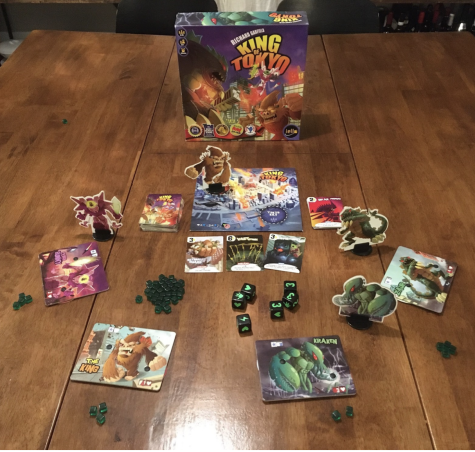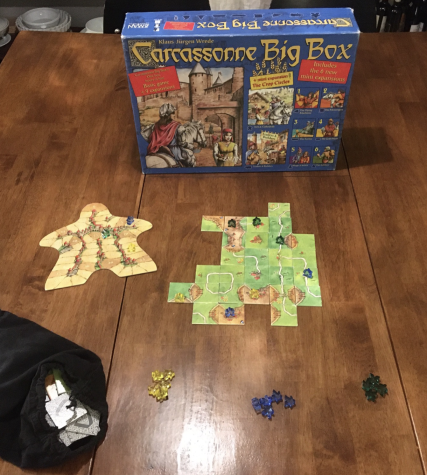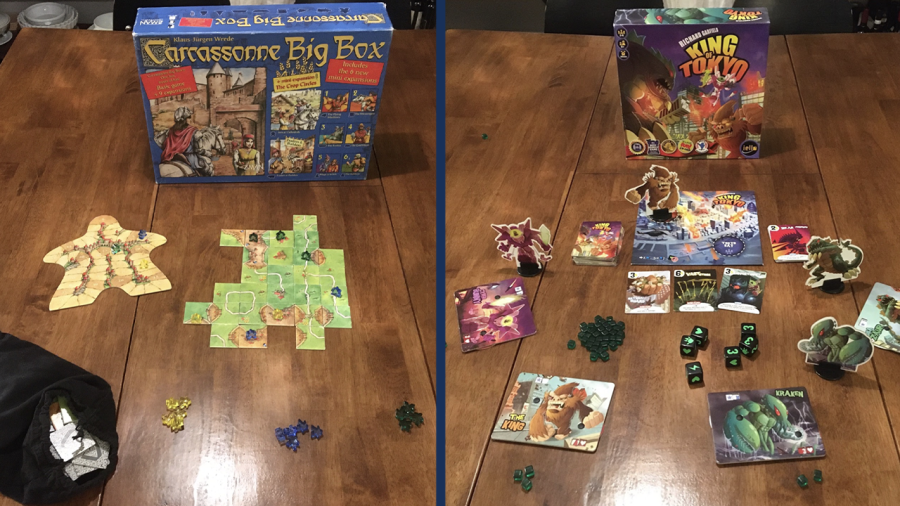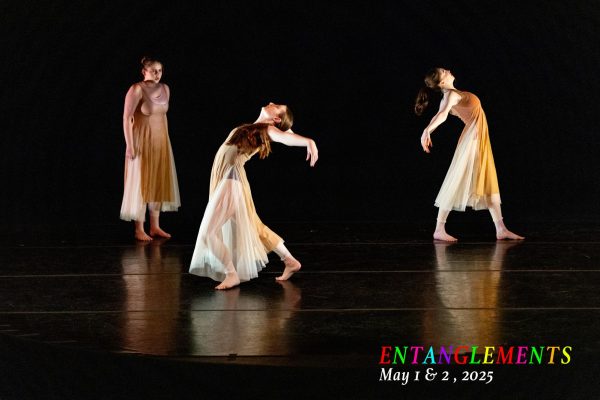Never Bored With Board Games
In this issue of Never Bored with Board Games, you will see an easier set of board games. While each one is challenging in its own way, all of them are simple enough to understand and explain in less than five minutes.
King of Tokyo
Difficulty Level: 2
Play Time: 20-30 minutes
Number of Players: 2-6
Recommended Age: 7+
Players compete to take control of Tokyo in this classic “King of the Hill” type game. On your turn, you roll dice to amass energy, attack your opponents, heal damage, and collect stars. You can also buy cards to give you special advantages.
There are eight dice used in King of Tokyo. Each die features six unique faces; a one, a two, a three, a paw, a lightning bolt, and a heart. On your turn, you may roll the dice up to three times, but you can also choose to not roll all of the dice. For example, let’s say your first roll is: 1, 1, 3, paw, paw, lightning. You decide to keep the paws and the lightning. You then have two rolls left. After rerolling the 1, 1, and the 3, you get: 2, 1, paw. You reroll just the 1 and 2 and get a 3 and a heart. After your three rolls, you now have paw, paw, paw, lightning, heart, 3.
After you have finished rolling, you must do all of the actions shown on your dice. Each paw deals one damage to your opponent(s), each lightning bolt gains you one energy cube, and each heart gains you one heart. The numbers on the other hand are a little more complicated.
If, and only if, you roll three or more of the same number, then you may gain a number of stars equal to the number on the dice plus one for each extra die showing the same number past the third one. For example, if you ended your roll with three 2s, you would gain two stars. If you had four 3s, you would gain four stars.
You can spend your energy cubes to buy cards that can give you special abilities and power-ups. Some cards give you hearts and stars, while others damage your opponents.
There are two spaces in Tokyo: Tokyo City and Tokyo Bay (which is only used if there are 5-6 players in the game). If you are in Tokyo City, then you deal damage to every player whenever you deal damage. Additionally, you gain two stars every time you start your turn in Tokyo City. The only downside to this is that you cannot gain hearts while in Tokyo City. If you deal damage while not in Tokyo City, then you only deal damage to the player in Tokyo City. Tokyo Bay follows the same rules.
In King of Tokyo, there are two ways to win. The first way is to be the last one standing. You can do this by killing your opponents (reducing their health to zero). The other way is to reach 20 stars first. This is the more versatile option for winning the game, since there are more ways to get stars than to damage your opponents.
King of Tokyo offers a less strategic way of being competitive. Even though it is simple, it is still as satisfying as any other game. There are basically no downsides to King of Tokyo except that players rely a lot on luck to win the game.
One Night Ultimate Werewolf
Difficulty Level: 2
Play Time: 5-15 minutes
Number of Players: 3-10
Recommended Age: 8+
This game requires an app
Like the classic game of Mafia, players converse and vote to find the werewolf (or werewolves) hiding among them. At the beginning of the game, each player is dealt a role known only to them. Then, night falls. Players will secretly change the roles of other players, alliances will reform, and the previously innocent could now be monstrous werewolves.
The app in this game acts as the storyteller. It announces which player takes their action during the Night phase.
In One Night Ultimate Werewolf, there are three phases: Role Assignment, Night, and Day. During the first phase, each player gets a role and looks at it. Additionally, three extra roles are placed face down in the center of the table. In the Night phase, everyone closes their eyes and puts their role tile face down in front of them after looking at it. The app then announces which players should open their eyes (sequentially, of course). The doppelganger, werewolves, minion, masons, robber, seer, troublemaker, and insomniac will open their eyes during the night. Each one has a different ability.
The doppelganger looks at another player’s role and is now that role for the rest of the game. The werewolves simply open their eyes to see who else is a werewolf (so they know who is on their team). The minion wakes up and sees who the werewolves are. The werewolves do not know who the minion is. The masons wake up and see each other. The robber switches their role with another person’s and then looks at their new role. The seer looks at another player’s role or two of the center roles. The troublemaker switches two other players’ roles without looking at them. And finally, the insomniac wakes up and looks at their own role. The villagers, hunter, and tanner do not wake up in the night.
During the day phase, everyone wakes up. They then have five minutes to discuss before they must vote. There are three teams in One Night Ultimate Werewolf: the werewolves, the citizens, and the tanner. The werewolves win if none of the werewolves are voted out. The citizens win if at least one of the werewolves are voted out. The tanner, however, wins if they get voted out.
Essentially, One Night Ultimate Werewolf is Mafia 2.0. It is more advanced, but doesn’t require persuasive skills. Players rely on trickery and misinformation to win the game.
Note: The box in the background includes all of the expansions. The regular box is much smaller.
Carcassonne
Difficulty Level: 3
Play Time: 40-80 minutes
Number of Players: 2-4
Recommended Age: 8+
If you are looking for a perfect mix of luck and strategy, then this is the game for you. In Carcassonne, players take turns randomly drawing tiles from a bag, then placing them adjacent to other previously placed tiles. Each tile displays a city, a road, farmland, or combination of them.
In Carcassonne, you build the board as you play, so whenever “the board” is mentioned, it is referring to the tiles that have already been placed. In a turn, the first thing you do is draw a tile from the bag. Then you have to decide where you want to place the tile. Based on the orientation of cities and roads, there may be places where you will not be able to place the tile. For example, when placing a tile that features a road, you may play that tile so that the road connects to another open road on the board. The same goes for cities and farms.
Following that, you have the option of placing one of your meeples (the person-shaped playing piece) on that tile. If you decide to do so, then you can play it on the city, road, or farmland. This means that you have “claimed” the area. After some time, a city or road may be completed: It is entirely closed off on all ends. The player with the most meeple in that area then scores points.
If an opponent has control of a city, road or farmland that you want, you can try to compete for control of that area. You can’t directly place a meeple in an area already occupied by a meeple—even if it is your own. In order to compete for control, you have to place a meeple in the area adjacent to the area you are trying to compete for, then connect the tiles using one or more tiles on a later turn. This may seem difficult, but there are a lot of tiles in the game, so you will have plenty of time to connect (although you may also have more if you are playing with expansions). Speaking of expansions, there are over six expansions for Carcassonne, so it is hard to get bored of this game.
Carcassonne is a play-with-what-you’re-given type of game. It is difficult to form long-term strategies since the board is always changing and you don’t know which tiles you will draw in the future. Because of this, Carcassonne can be played in a relaxed environment just as easily as a competitive one. This is also a great game to teach children, given that it does not require any reading and is simple.
Winston Spreitzer ('24) is delighted to be returning as a staff writer to The Forum this year. In the past, he has written articles about rock climbing,...




















































